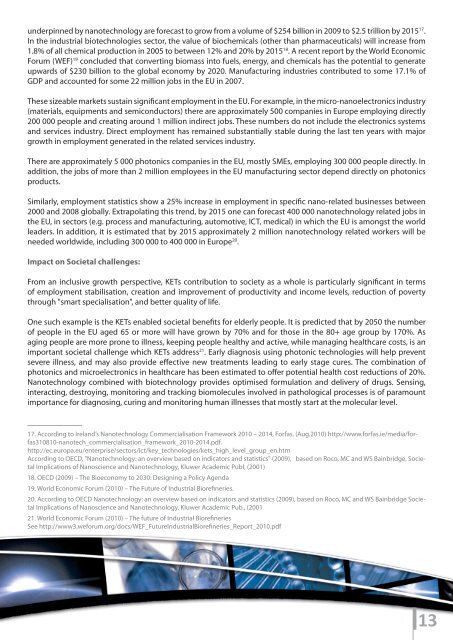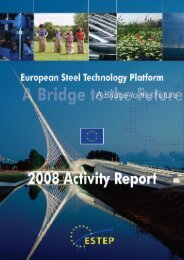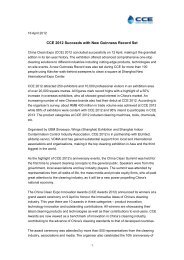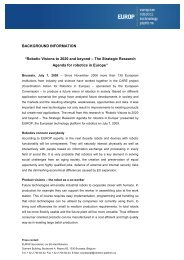Final report on Key Enabling Technologies - European Commission ...
Final report on Key Enabling Technologies - European Commission ...
Final report on Key Enabling Technologies - European Commission ...
You also want an ePaper? Increase the reach of your titles
YUMPU automatically turns print PDFs into web optimized ePapers that Google loves.
underpinned by nanotechnology are forecast to grow from a volume of $254 billi<strong>on</strong> in 2009 to $2.5 trilli<strong>on</strong> by 2015 17 .<br />
In the industrial biotechnologies sector, the value of biochemicals (other than pharmaceuticals) will increase from<br />
1.8% of all chemical producti<strong>on</strong> in 2005 to between 12% and 20% by 2015 18 . A recent <str<strong>on</strong>g>report</str<strong>on</strong>g> by the World Ec<strong>on</strong>omic<br />
Forum (WEF) 19 c<strong>on</strong>cluded that c<strong>on</strong>verting biomass into fuels, energy, and chemicals has the potential to generate<br />
upwards of $230 billi<strong>on</strong> to the global ec<strong>on</strong>omy by 2020. Manufacturing industries c<strong>on</strong>tributed to some 17.1% of<br />
GDP and accounted for some 22 milli<strong>on</strong> jobs in the EU in 2007.<br />
These sizeable markets sustain significant employment in the EU. For example, in the micro-nanoelectr<strong>on</strong>ics industry<br />
(materials, equipments and semic<strong>on</strong>ductors) there are approximately 500 companies in Europe employing directly<br />
200 000 people and creating around 1 milli<strong>on</strong> indirect jobs. These numbers do not include the electr<strong>on</strong>ics systems<br />
and services industry. Direct employment has remained substantially stable during the last ten years with major<br />
growth in employment generated in the related services industry.<br />
There are approximately 5 000 phot<strong>on</strong>ics companies in the EU, mostly SMEs, employing 300 000 people directly. In<br />
additi<strong>on</strong>, the jobs of more than 2 milli<strong>on</strong> employees in the EU manufacturing sector depend directly <strong>on</strong> phot<strong>on</strong>ics<br />
products.<br />
Similarly, employment statistics show a 25% increase in employment in specific nano-related businesses between<br />
2000 and 2008 globally. Extrapolating this trend, by 2015 <strong>on</strong>e can forecast 400 000 nanotechnology related jobs in<br />
the EU, in sectors (e.g. process and manufacturing, automotive, ICT, medical) in which the EU is am<strong>on</strong>gst the world<br />
leaders. In additi<strong>on</strong>, it is estimated that by 2015 approximately 2 milli<strong>on</strong> nanotechnology related workers will be<br />
needed worldwide, including 300 000 to 400 000 in Europe 20 .<br />
Impact <strong>on</strong> Societal challenges:<br />
From an inclusive growth perspective, KETs c<strong>on</strong>tributi<strong>on</strong> to society as a whole is particularly significant in terms<br />
of employment stabilisati<strong>on</strong>, creati<strong>on</strong> and improvement of productivity and income levels, reducti<strong>on</strong> of poverty<br />
through "smart specialisati<strong>on</strong>", and better quality of life.<br />
One such example is the KETs enabled societal benefits for elderly people. It is predicted that by 2050 the number<br />
of people in the EU aged 65 or more will have grown by 70% and for those in the 80+ age group by 170%. As<br />
aging people are more pr<strong>on</strong>e to illness, keeping people healthy and active, while managing healthcare costs, is an<br />
important societal challenge which KETs address 21 . Early diagnosis using phot<strong>on</strong>ic technologies will help prevent<br />
severe illness, and may also provide effective new treatments leading to early stage cures. The combinati<strong>on</strong> of<br />
phot<strong>on</strong>ics and microelectr<strong>on</strong>ics in healthcare has been estimated to offer potential health cost reducti<strong>on</strong>s of 20%.<br />
Nanotechnology combined with biotechnology provides optimised formulati<strong>on</strong> and delivery of drugs. Sensing,<br />
interacting, destroying, m<strong>on</strong>itoring and tracking biomolecules involved in pathological processes is of paramount<br />
importance for diagnosing, curing and m<strong>on</strong>itoring human illnesses that mostly start at the molecular level.<br />
17. According to Ireland’s Nanotechnology Commercialisati<strong>on</strong> Framework 2010 – 2014, Forfas, (Aug.2010) http://www.forfas.ie/media/forfas310810-nanotech_commercialisati<strong>on</strong>_framework_2010-2014.pdf.<br />
http://ec.europa.eu/enterprise/sectors/ict/key_technologies/kets_high_level_group_en.htm<br />
According to OECD, "Nanotechnology: an overview based <strong>on</strong> indicators and statistics" (2009), based <strong>on</strong> Roco, MC and WS Bainbridge, Societal<br />
Implicati<strong>on</strong>s of Nanoscience and Nanotechnology, Kluwer Academic Publ, (2001)<br />
18. OECD (2009) – The Bioec<strong>on</strong>omy to 2030: Designing a Policy Agenda<br />
19. World Ec<strong>on</strong>omic Forum (2010) – The Future of Industrial Biorefineries.<br />
20. According to OECD Nanotechnology: an overview based <strong>on</strong> indicators and statistics (2009), based <strong>on</strong> Roco, MC and WS Bainbridge Societal<br />
Implicati<strong>on</strong>s of Nanoscience and Nanotechnology, Kluwer Academic Pub., (2001<br />
21. World Ec<strong>on</strong>omic Forum (2010) – The future of Industrial Biorefineries<br />
See http://www3.weforum.org/docs/WEF_FutureIndustrialBiorefineries_Report_2010.pdf<br />
13
















